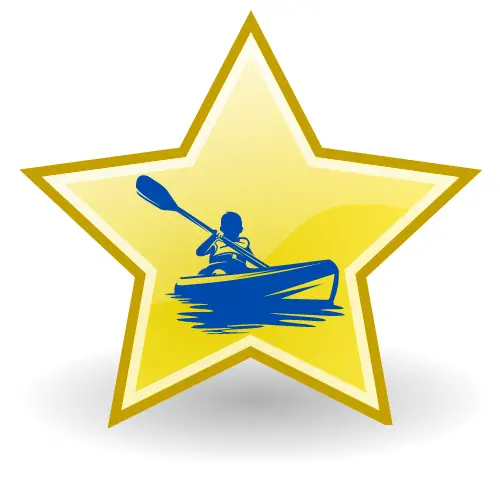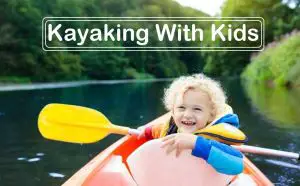Kayaking is becoming more and more popular. And no wonder – it’s a great adventure combined with healthy physical activity! But is it possible to go kayaking with children? Of course, you can! Based on my many years of experience in organizing such expeditions. I want to tell you in the article what you should pay attention to in the first place so that rafting with a child becomes an unforgettable experience for the whole family.
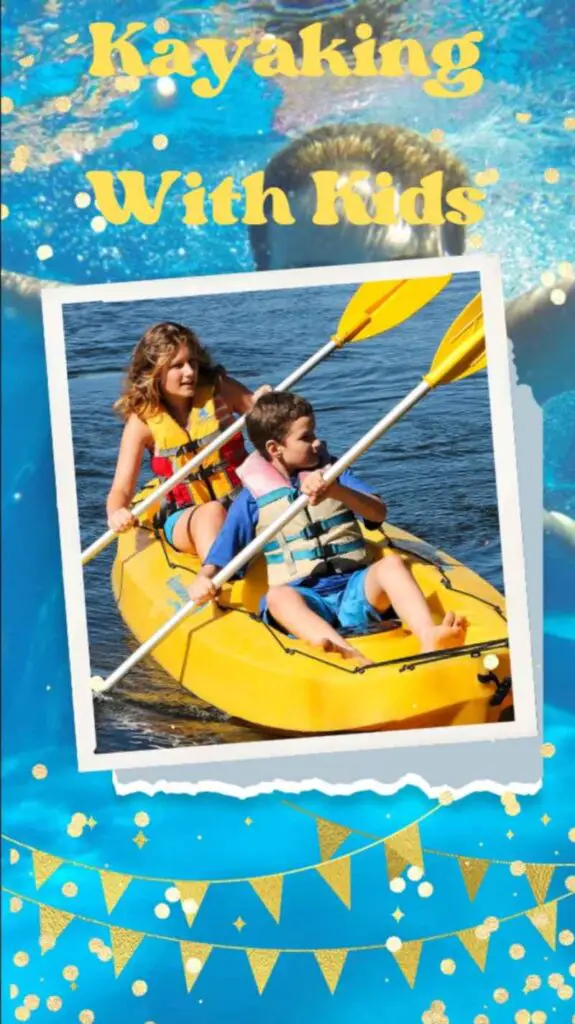
Table of Contents
Kayaking with kids – when can you start?
One of the biggest problems with planning kayaking with kids is that most advice and opinions lump all kids together. So you may hear that: the river should be easy, low-lying, and shallow, and the kayak should be a 3-person kayak, but these are simplifications that will really only work well with a specific group of children. Rarely, however, will you hear that canoeing with a school child is governed by slightly different rules than canoeing with a preschooler.
Rafting with an infant or year-old

Unfortunately, for safety reasons, rafting with a child under 3 is not a good idea. Although on a day-to-day basis, a little toddler can sometimes be easier to tame than an exuberant 4-year-old, with such young children there are a few special considerations to take into account.
Kayaking with an infant is dangerous because of
- Difficulty fitting a life jacket – few kayak rental companies offer life jackets for infants, and wearing one that is too large can cause the child to slip out of it or over the head, which is very dangerous in the event of a capsize.
- The difficulty for an infant to accept a life jacket – the large collar and thick material with buoyancy foam is uncomfortable and restricts the movements of a small child, so it is very easy for him to cry. What, dear Parent, do you do in such a situation? Under no circumstances should you remove the child’s vest, because in the event of a capsize it is extremely dangerous (and in addition to obstacles in the riverbed, it is incompetent getting in and out of the kayak that is the most common cause of capsizes).
- Not knowing whether an infant is allergic to insect stings – is very rarely mentioned, but it is one of the most important reasons why you should say “no!” to rafting with children under 2. Severe allergy to insect venom is a rare condition, but until your child encounters it, you won’t know if it affects your little one. However, if anaphylactic shock due to a sting occurs, your only recourse is to call an ambulance urgently, and if you are on the river at the time, it simply won’t reach you.
- Motoring a child in a sling or carrier is insanely dangerous during rafting! – In the event of a capsize, the parent’s head is above the water, and the child is all under the surface. You also can not delude yourself that, after all, the water is up to your knees, because falling out of the canoe, you fly sideways straight into the water, and do not immediately land on straight legs. And then the child lands all the way in the water along with the parent.
- Overly preoccupied with the child – whoever has a toddler knows how much attention needs to be paid to him, and on kayaks, it will not be easier with this. In the case of swimming in a configuration of 1 parent + infant, his desire to climb and crawl and put in his mouth the leaves that fall from the trees, and licking his hands dirty from the bottom of the kayak is not only tiring but also distracting from steering the kayak.
Expert's tip: We advise you to postpone rafting with a child under 3 years old.
Kayaking with a preschooler
You can already start familiarizing a 3-year-old with a kayak, as it is much easier to ensure his safety. However, the basic rule is to graduate the length of rafting.
- 1 hour of swimming – for the first rafting trip for a 3-4-year-old;
- 1-3 hours of floating – for the next two-three rafting trips for a 3-4-year-old or as the first for a 5-year-old (you should observe the attitude of the child and decide on the fly whether you finish after an hour or keep swimming);
- 3-5 hours – for the next rafting trip for a preschooler (only if he has been on shorter rafting trips several times and 100% liked it);
- 2-3 day trips, when the child has caught the bug.
Of course, this is not a rigid framework, but a pattern, well received by kids. With frequent trips to the river, you can “rewrite” all these points in a year, as a result, you can have a 3-year-old kayaker who can swim for 5 h without a problem. However, you should never throw a 3-year-old into the deep end, even when there are children of a similar age among your friends who can swim that much. The best idea for the first canoeing trip with a child is to organize a weekend trip to a lake/river, during which the canoeing will only be a supplement to swimming, walking, and cycling, and not an end in itself. At the same time, it is worthwhile to take care of a number of small attractions for children, such as big soap bubbles, field games, educational walks, or common bonfires.
As a rule, river rafting is more interesting than lake rafting, because the landscape changes all the time. However, it should be remembered that canoe stops are rarely within a 1 hr swim, so you should make an effort to choose your route so that there are as many as possible. Another way is to choose a lazy river, which you can return to by swimming upstream.
Tips for first kayaking with a 3-4-year-old child
- Familiarize your child with kayaking equipment already on land so that he feels comfortable and safe in it. To learn how to do this, read: How to prepare a young child for a canoeing trip.
- For the first rafting trip with children, choose a short route, about 1 h of swimming. The following trips you can already gradually lengthen.
- For the first rafting trip, choose a simple, calm, lowland river, so that they can get used to the kayak calmly.
- Prepare games to make the rafting trip more interesting.
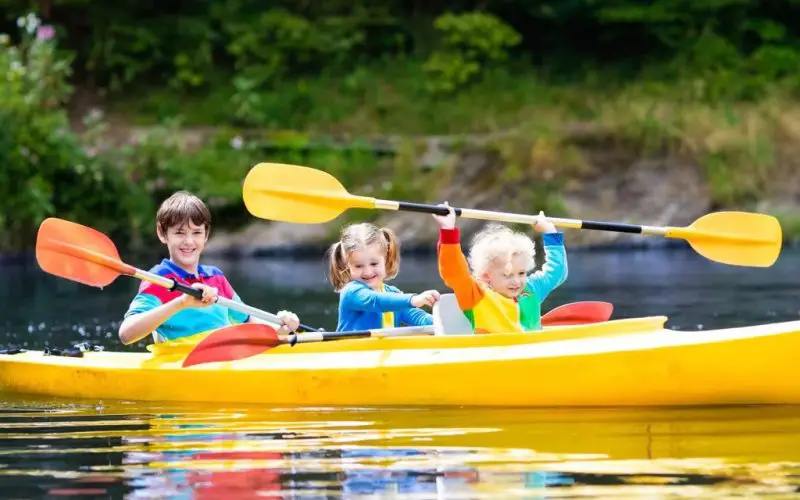
Kayaking with a school-aged child
If you’re considering a kayaking trip with your school-aged children, you can easily go even on a several-day trip. This is a great alternative to vacation in the USA, as it doesn’t cause boredom-induced fits of whining, unlike a few hours of sightseeing. As our experience shows, even a 7-year-old with no prior familiarity with kayaking should be fascinated by such an adventure.
However, it is important to remember that a 7-year-old is no longer a toddler who is afraid of new circumstances – he needs attractions, challenges, and a healthy adrenaline rush! So don’t suggest that the river for canoeing with children must be as calm and lazy as possible because by following this advice with older and more demanding kids, you will probably contribute to the fact that they will not love canoeing as much as you would like them to.
What to do to make an older child enjoy rafting:
- Don’t choose the easiest river, but choose an attractive route that matches your skills – kayaking on an easy river, especially for older children, is simply boring. You can read more about the topic of selecting a route for kayaking with children in the rest of the article.
- On a rafting trip with your child, take his peers – nothing works better for children than the company of friends. You can race together, splash around, and have a full-on party at the camping spot. This is how cool memories are born and friendships deepen.
- For teenagers swimming under the guidance of experienced kayakers, take single-person kayaks – There comes an age when a child begins to have a need for independence and to test their abilities, and swimming in singles fits perfectly into these needs. However, never let your teenager go canoeing without experienced adult supervision!
Because of our readiness for multi-day trips, our rafting trips are aimed specifically at school-aged kids, including teens. Of course, we don’t want to discourage parents of younger kids from this type of activity, but we encourage them not to throw their children into too deep a water, but first to get used to the canoe on shorter trips.
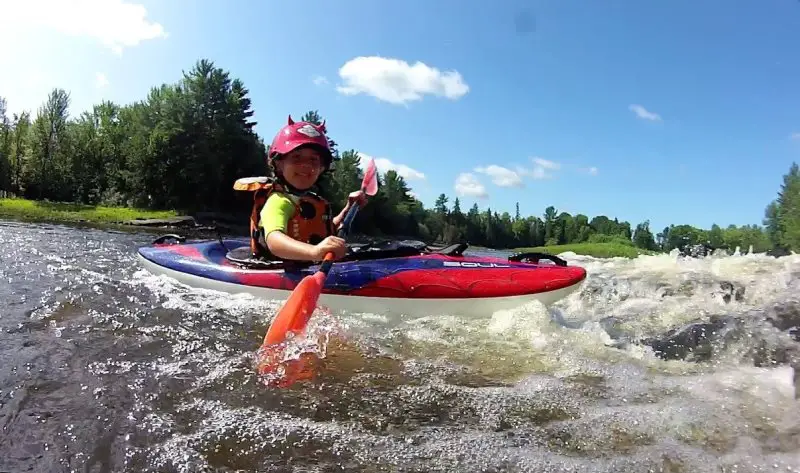
Where to go kayaking with kids? The myth of the easiest possible river
What river is good for kayaking with kids?
A lot depends on where you live. Depending on whether the river is rough or not, you can always find the right place. Here is a small list of popular rivers:
- Nicolet Beach, Wisconsin
- Caddo River, Arkansas
- Channel Islands, California
- Mono Lake, California.
But you can find suitable rivers in other parts of the U.S. We have a lot of rivers, which make the most famous ones crowded. And here you have to ask yourself: is this an advantage or a disadvantage for you?
From our experience, we can advise that for:
- short rafting trips with a preschooler – bet on proximity to home and ease of the route
- canoeing with a school child – go farther, but show the child a more interesting river (especially if sleeping in tents is involved)
In the article U.S. Kayaking Places, we described popular places around the states that we particularly recommend for short and week-long trips. Unfortunately, we cannot recommend one route that is right for everyone, because no such route exists. You must judge for yourself which one is best for you and your family.
Skills vs. rafting route with children
First of all, the route must be tailored to your skills. The saying goes that you can drown even in a spoonful of soup, so the depth of the water is not of the greatest importance. For you, a river with a depth of 1 m will reach your navel, but for a 7-year-old higher than your neck.
What to consider when assessing the difficulty of a river for rafting with a child (and more):
- The current of the river – sections with rapids are more dangerous because it is more difficult to control the canoe;
- Water thresholds – these are small waterfalls that, in most cases, should be avoided by the bank. When one misses a threshold and enters it, it becomes very dangerous with a lack of skill;
- The number of overhangs – a large number of fallen trees, lying in the riverbed very significantly increases the possibility of capsizing, especially if you have no experience in overcoming them;
- Branches hanging over the river – banks abundantly overgrown with osiers generate the risk of getting caught in them with your hair or a badly dressed vest (that’s why instruction in the use of equipment is important!).
- Depth of the river – it is easier to control the situation after a capsize when you can stand on the bottom of the river than when this is not possible.
You should ask yourself: do I know how to behave appropriately in such situations? If so, then you have a huge number of rivers to choose from, so a trip with an older child will certainly not be monotonous! If, on the other hand, you are inexperienced, then choose river sections where there are as few as possible. If you have school children and no kayaking experience, we especially encourage you to go on an organized rafting trip. Such trips offer the perfect balance between safety and attractiveness of the route, as you will be supervised nonstop by an instructor, who will teach you techniques for overcoming obstacles on occasion.
Once you have selected a river, the next step is to learn its route in detail. To do this, it’s a good idea to type “mileage and name of the river” into an Internet search engine and familiarize yourself with the difficult places that occur along its route. However, you should keep in mind that the kilometer will not indicate the presence of fallen trees, as their number varies many times, even in the same season. Such field reconnaissance should be carried out not only when planning a kayaking trip with children, but on every rafting trip, regardless of who will be participating.
When planning a route for kayaking with children, take into account:
- The pace of the swim – on a fairly easy river, if you paddle calmly, you will go at an average speed of 4 km/h, and with a lot of obstacles, the pace may decrease to 2-3 km/h
- Frequency of places where you can go ashore – the smaller the child, the more breaks he will need
- Possibility of shortening the rafting trip – in the case of kayaking with an unaccustomed or simply small child, you have to reckon with the fact that at some point he may say “enough”. So check beforehand if there are other camping areas or roads near the waterway that will allow you to get there.
- Measure your strength against your strength – this is especially important if a mother and child are to go in one canoe. There is no way to count on a small child being able to paddle effectively, so the “propulsion” of the kayak will only be a mom. This is especially important when paddling through lakes because on them you can’t count on the current of water to carry the kayak.

Three most important rules of rafting with children
One caregiver per child!
On a rafting trip with children, you should never have more children in your care than you can actually keep safe in a capsize – that is, one adult per child. Yes, by having life jackets, children will float to the surface without any problem, but their panic alone is a reason for urgent help.
It is optimal when in a canoe goes:
- a parent with one child;
- two parents and one small child;
- a parent with two children, and another adult next to him in another kayak.
Don’t kayak alone!
This is a general rule, not just for kayaking with children. You never know when you will need help, so there should always be someone beside you. Hence, the best solution is to plan a trip together with friends or go on an organized family rafting trip.
There should be at least one experienced person in the group who will be the commander (boss) on the water. Rafting with only inexperienced people is like going from the rain into the gutter because in case of any difficulties, no one will know how to react quickly and appropriately anyway. Of course, the larger the rafting with children, the more experienced people should be present.
Don’t drink alcohol on a rafting trip with your child!
Although, in principle, you should just write: do not drink, regardless of whether you raft with your family or alone. It is against the law in all U.S. states to operate a boat, from a kayak to a mega-yacht, while intoxicated, and violating these rules can result in severe penalties, including jail time. Please do not put your child in danger because you have impaired concentration, impaired thinking, and slow reactions. The river and lake are not an easy walk, you really need to think soberly here.

What to do to make canoeing with children safe?
Rest assured, kayaking is safe! As long as you follow a few rules, you really have nothing to fear
Belay or life vest?
The most important rule when kayaking with children (but not only) is to wear a safety vest or life jacket. This applies not only to children but also to adults. Even if you feel like a fish in the water, set a good example for your child by teaching him or her that preventing an accident is better than providing assistance. Normally, vests are rented along with kayaks and paddles, so you don’t have to buy your own. However, it is worth making sure that the rental company has life jackets available.
- Buoyancy vest – this is for children swimmers, teenagers, and adults (regardless of whether they can swim)
- Life jacket – for non-swimming children. It has a collar to support the head and crotch straps to prevent the bottom from slipping out.
When going kayaking with your child, under no circumstances should you dress him or her in an inflatable vest for a few zlotys, as it will not provide safety (easy to perforate and no crotch straps). In addition, for many children, it is uncomfortable due to hard welds.
When choosing a belay vest, pay attention to:
- Fitted to a person’s weight – each kapok has a fixed displacement.
- Fitted to the posture – vests come in different sizes, plus straps that adjust the waist circumference and the fit to the shoulders. The vest should be dressed in such a way that it fits tightly to the body everywhere, including the shoulders, but does not impede breathing.
How to use a life jacket properly:
- Always have it fastened and well-fitted;
- Do not sit on it – under the influence of weight, the foam compacts and loses buoyancy;
- Do not dry by the fire – the foam will melt quickly.
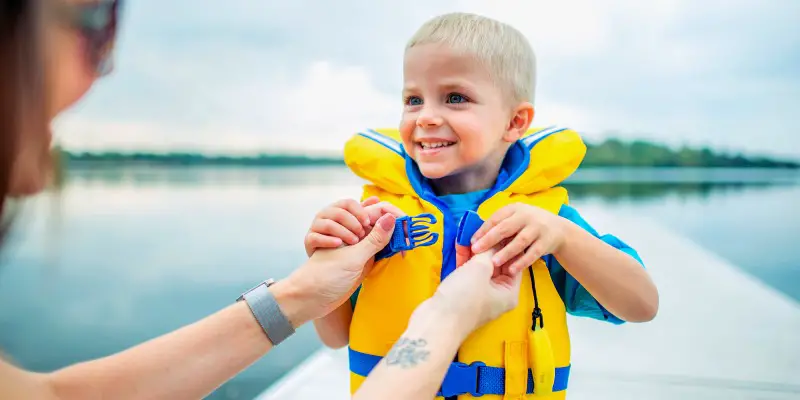
Which kayaks for canoeing with a child?
Rental companies usually stock touring kayaks that have a wide bottom, making them a little tippy, and therefore suitable even for beginning kayakers and families with children (vista kayaks are our favorite). Therefore, the main focus should be on whether you need a two-person kayak or a three-person family kayak.
We suggest:
- 2+1 family (preschooler) – a 2-person kayak with a large cockpit, equipped with an extra seat for a small child. In such a kayak the child sits closer to the parent, so it is easier to control him.
- Family 2 + 1 (schoolboy) – a 3-person kayak with three cockpits or two kayaks: 2-person and 1-person/2-person, depending on your experience. For teenagers, it is worth taking a single.
- A 2+2 family – two 2-person kayaks. Doubles are much easier to turn than a four-person kayak (and there are some).
- Larger family – sail with extended family or friends, and one child sits in each 2-person kayak.
Arrangement of people in a kayak
In two-person kayaks, a parent and child should always go, not two children alone. Teenagers are an exception, as they can easily handle kayaking on their own (under adult supervision, of course).
Always the parent should sit in the back (because it is from this place that the kayak is steered), and the child in the front.
If you go kayaking with a teenager or another adult – the heavier person sits in the back.
Is a helmet required for rafting with children?
If you do not plan to raft wild mountain rivers, there is no need. You may want to consider it if you plan to float along the so-called rapids (sections of the river abundant with fallen trees and other obstacles), but it is not an absolute necessity.
Tying to the kayak
Under no circumstances should a kayak be tied to a child – and no matter what length or thickness of the line you use for this! It is enough if the kayak capsizes on a tree lying across the river, and the rope becomes entangled against one of the branches in such a way that the child is wedged under the water… Besides, you do not even need a log lying in the riverbed for a tragedy. A simple capsize combined with a child’s panic is enough, which can result in a rope wrapped around the neck… It is much better to “chase” the child a little in the water than to expose him to irreversible consequences.
Also, animals should not be tied to the kayak!
However, you can tie a waterproof bag with things.
What to look for when choosing a rental for rafting with children?
As we float on different rivers, we have seen more than once those rental rentals are not equal. So when booking kayaks, it’s worth asking about a few things.
- Equipment suitable for rafting with children – first of all, the availability of kayaks for 3 people (if you need them) and life jackets (if you have a non-swimming child)
- Recommended sections for family rafting – a good rental company should be able to advise you well.
- Providing instruction in the use of equipment – professionals should always instruct you on how to fasten vests, how to get into the kayak, paddle, and maneuvering
- The option to go with an instructor – if you are going kayaking for the first time with children or simply do not feel confident, this is the best option, because, on the one hand, it guarantees safety, and on the other, it gives you space to learn to swim well.
- Transportation after the rafting trip – there are two practices: either the rental company takes the drivers to their cars and they then return to pick up the rest of the family, or the company takes the whole family right away. It is known – the second option is more convenient.
- The need to book kayaks – this is especially important if you go rafting on a weekend and have chosen a popular route.
What to wear on a kayak trip with kids?
Canoeing with a child is quite a challenge for moms, as it is usually their responsibility to properly dress and pack the kids. Onion clothing works best here.
- A baseball cap or a well-fitting hat for the head – without it, not a movie! The sun can bake hard, and on an exposed river you can’t escape it, so without headgear, it’s easy to get a stroke;
- Sunglasses – not necessary, but can be very useful for your own comfort;
- Swimsuit – it’s a good idea to wear it instead of underwear and let your child jump into the water after the rafting is over;
- Short-sleeved blouse and short shorts, if it’s warm – it’s essential to wear one that doesn’t hurt and dries as quickly as possible (beware, cotton takes a long time to dry, so while it will bring a pleasant cooling for adults, it may be uncomfortable for children);
- Long pants (preferably also quick-drying) and a rain jacket dressed in short sleeves when it’s cooler. Such a jacket works much better than a sweatshirt because it does not soak up water. For parents, however, long pants are not recommended, as it is often necessary for a parent to get out of the kayak and stand in the water;
- Old sandals or water sports shoes.
- If you go kayaking with your child in the autumn or early spring, a neoprene water sports foam can be useful. However, in summer it is completely unnecessary.
What to take on a kayaking trip with children?
First of all, keep in mind that a kayak is not a luggage carrier – not everything will go into it. So be sure to pack thoughtfully what you are going to take on a rafting trip with your child. Among these items should be:
- A charged and waterproof phone – in case you need to call for help;
- A first-aid kit, and in it the most necessary things (e.g., plasters, something for burns, allergy medications in case you are rafting with an allergy sufferer, especially if they are allergic to insect venom!);
- Food – both something substantial, e.g. sandwiches, cold pancakes, and snacks that will make the kids’ swim more pleasant, e.g. small sweets (preferably not covered in chocolate, as they will melt quickly in the sun), nuts, fruit. Don’t take anything into the kayak that needs to be reheated, as you won’t have anywhere to do it;
- Drinking water in plenty (at least 1.5 liters per person);
- A set of changing clothes for everyone – underwear, shorts, T-shirt;
- A rain jacket or cape – it’s good to have one at all times, regardless of the forecast, even if it’s warm (especially when rafting with a child). When the child starts complaining that he is cold, you can cover him with a jacket;
- Headgear for everyone! – sailing between fields or on a lake, it is impossible to hide from the sun, so it is not difficult to get sunstroke;
- UV sunscreen (at least 30) – by the water it always burns more, even if the sun is hidden behind clouds;
- Something mosquito repellent – over water, and especially before a storm, mosquitoes cut even during the day;
- Toilet paper and a shovel in case you urgently need to go to the forest toilet;
- A kayaking map of the river in question, if not going with an instructor;
- A waterproof bag to store these things – of course, the most reliable is a professional sailing bag. However, if you do not plan systematic kayaking trips, then disposable or string bags will successfully suffice. It is best to put them in addition to one or two tied-up commercial bags or garbage bags.
- Garbage bag – during the rafting trip you are bound to “produce” some garbage, be it water bottles or snack wrappers, and floating on the water you will not find any trash. The river such a garbage can should not be either.
- A sponge to pull water out of the kayak – this is the easiest way to dry off after a capsize or splash. Not every rental company gives it in a set, so to make your life easier, it is worth getting one yourself. It’s a good idea to make it A5-A4 in size and about 10 cm thick (of course, the dimensions can be different, but it’s important that it’s not the size of a dishwashing sponge).
Rafting with a child – benefits for the family
In addition to being a great attraction in itself, kayaking also has another benefit – it brings people closer together. Overcoming obstacles together teaches cooperation and reliance on each other, showing at once what results when it works perfectly and what results when cooperation limps along. In turn, there is no better learning than through one’s own experience! In addition, a couple of hours spent together in the same canoe is an ideal opportunity to talk, and much deeper than “what was in school today.”
After all, in pleasant circumstances o easier to open up. Rafting with children is a great adventure for both young and old. However, in order to get the maximum joy and safety out of it, you need to approach the subject with your head, and preferably just use the offer of organized trips. Then none of you will get a headache from over-planning.
Our best posts:
